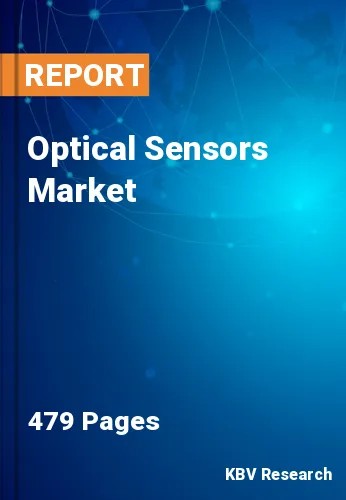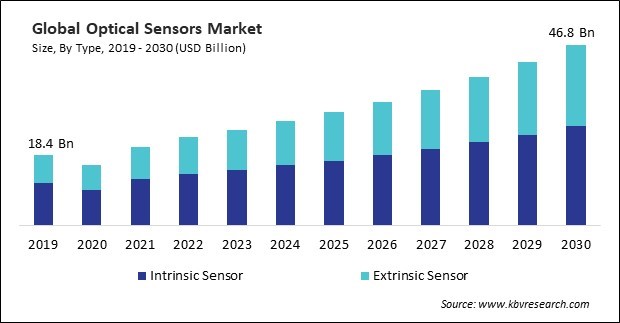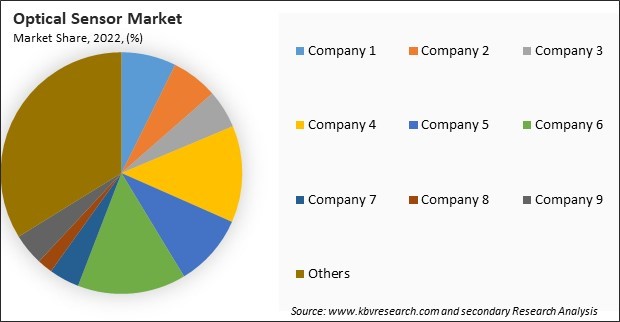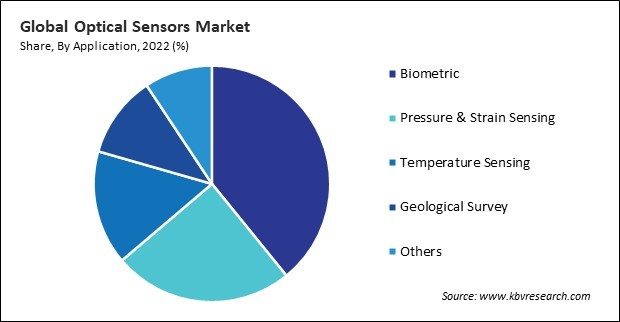
The Global Optical Sensors Market size is expected to reach $46.8 billion by 2030, rising at a market growth of 9.4% CAGR during the forecast period. In the year 2022, the market attained a volume of 1,70,306.4 thousand units, experiencing a growth of 10.8% (2019-2022).
Optical sensors are vital in guidance systems for missiles and other precision-guided weapons. Infrared optical sensors detect threats, including heat signatures and potential threats. Infrared sensors enhance situational awareness, enabling timely responses to security risks in military and civilian aerospace applications. Consequently, the aerospace & defense segment would generate approximately 26.28% share of the market by 2030. Optical sensors are laser range finders in military applications, providing accurate distance measurements. Laser range finders contribute to precise targeting and situational awareness, supporting military operations across various environments.

Optical sensors are used in solar panels and wind turbines for monitoring and control applications. The global focus on renewable energy sources fuels the demand for optical sensors to enhance the efficiency and performance of renewable energy systems. Optical sensors are used in solar PV systems for sunlight tracking, irradiance measurement, and fault detection. The demand for efficient solar energy generation drives the deployment of optical sensors to enhance the performance and reliability of solar PV installations. Therefore, the market is expanding significantly due to the increasing demand for renewable energy sources. Moreover, Optical sensors are employed to monitor the health of crops by capturing spectral information related to plant conditions. Optical sensors, including satellite and drone-based imaging systems, provide high-resolution imagery for agricultural remote sensing applications. Thus, because of the expanding applications in agriculture, the market is anticipated to increase significantly.
However, High manufacturing and implementation costs can make optical sensors less accessible to a broader market, particularly in regions or industries with budget constraints. The limited market accessibility may hinder the widespread adoption of optical sensors, restricting their deployment to niche applications or high-budget projects. The high initial investment required for deploying optical sensors may result in a delayed or extended return on investment for end-users. Thus, high-cost considerations of optical sensors can slow down the growth of the market.

The leading players in the market are competing with diverse innovative offerings to remain competitive in the market. The above illustration shows the percentage of revenue shared by some of the leading companies in the market. The leading players of the market are adopting various strategies in order to cater demand coming from the different industries. The key developmental strategies in the market are Acquisitions, and Partnerships & Collaborations.
 Drivers
Drivers  Restraints
Restraints  Opportunities
Opportunities  Challenges
Challenges By type, the market is categorized into extrinsic sensor and intrinsic sensor. The extrinsic sensor segment covered a considerable revenue share in the market in 2022. Extrinsic optical sensors, such as fiber optic sensors, are widely used to monitor structures' strain and deformation in structural health monitoring applications. These sensors can be embedded in materials to provide real-time data on the structural integrity of bridges, buildings, and other infrastructure. The ability to measure strain and deformation in real time enhances the safety and maintenance of critical structures, contributing to the demand for extrinsic optical sensors in civil engineering and construction.
On the basis of application, the market is divided into pressure & strain sensing, temperature sensing, geological survey, biometric, and others. In 2022, the biometric segment dominated the market with maximum revenue share. Biometric optical sensors, such as fingerprint and iris scanners, enhance security measures in access control systems. Uplifting the biometric segment in optical sensors improves the accuracy and reliability of authentication processes, ensuring only authorized individuals gain access to restricted areas. Biometric sensors in optical devices are commonly used in workplace time and attendance systems. This ensures accurate tracking of employee work hours, prevents buddy punching and enhances overall workforce management.

Based on sensor type, the market is classified into fiber optic sensor, photoelectric sensor, optical temperature sensors, biomedical sensors, displacement & position sensors, and others. The photoelectric sensor segment acquired a substantial revenue share in the market in 2022. Photoelectric sensors are often designed in compact and space-efficient forms, allowing for easy integration into machinery, equipment, and automated systems with limited space. Photoelectric sensors are widely adopted in robotics and automation for object detection, pick-and-place operations, and navigation tasks. Photoelectric sensors operate on a non-contact principle, meaning they do not physically touch the objects they are sensing. This non-contact nature eliminates wear and tear, reducing maintenance requirements and increasing sensor lifespan.
By end-use, the market is segmented into healthcare, consumer electronics, energy & utility, aerospace & defense, automotive & transportation, manufacturing, and others. In 2022, the consumer electronics segment registered the maximum revenue share in the market. Optical sensors, such as ambient light, proximity, and fingerprint sensors, are integral to smartphones and tablets. These sensors contribute to features like automatic screen brightness adjustment, proximity-based touch controls, and secure biometric authentication, enhancing user convenience and device security. Optical sensors, including 3D depth-sensing cameras and infrared sensors, enable facial recognition technology in consumer electronics. Facial recognition enhances device security, facilitates secure authentication for unlocking devices, and supports features like augmented reality (AR) applications.
Free Valuable Insights: Global Optical Sensors Market size to reach USD 46.8 Billion by 2030
Region-wise, the market is analyzed across North America, Europe, Asia Pacific, and LAMEA. In 2022, the North America region acquired a significant revenue share in the market. North America has seen a rising integration of optical sensors in healthcare applications, including medical imaging devices, patient monitoring systems, and diagnostic tools. The North American automotive sector has incorporated optical sensors into safety systems such as lane departure warning systems, adaptive cruise control, and collision avoidance systems. North American industries have adopted optical sensors for industrial automation, robotics, and manufacturing processes to improve efficiency and precision.
| Report Attribute | Details |
|---|---|
| Market size value in 2022 | USD 23 Billion |
| Market size forecast in 2030 | USD 46.8 Billion |
| Base Year | 2022 |
| Historical Period | 2019 to 2021 |
| Forecast Period | 2023 to 2030 |
| Revenue Growth Rate | CAGR of 9.4% from 2023 to 2030 |
| Number of Pages | 479 |
| Number of Table | 920 |
| Quantitative Data | Volume in Thousand Units, Revenue in USD Billion, and CAGR from 2019 to 2030 |
| Report coverage | Market Trends, Revenue Estimation and Forecast, Segmentation Analysis, Regional and Country Breakdown, Market Share Analysis, Porter’s 5 Forces Analysis, Company Profiling, Companies Strategic Developments, SWOT Analysis, Winning Imperatives |
| Segments covered | Type, Sensor Type, Application, End-use, Region |
| Country scope |
|
| Companies Included | Honeywell International, Inc., Keyence Corporation, Amphenol Corporation, Cisco Systems, Inc., Texas Instruments, Inc., Renesas Electronics Corporation, STMicroelectronics N.V., Rockwell Automation, Inc., Sick AG, ams-OSRAM AG |
By Type (Volume, Thousand Units, USD Billion, 2019-2030)
By Application (Volume, Thousand Units, USD Billion, 2019-2030)
By Sensor Type (Volume, Thousand Units, USD Billion, 2019-2030)
By End-use (Volume, Thousand Units, USD Billion, 2019-2030)
By Geography (Volume, Thousand Units, USD Billion, 2019-2030)
This Market size is expected to reach $46.8 billion by 2030.
Increasing demand for renewable energy sources are driving the Market in coming years, however, High-cost considerations of optical sensors restraints the growth of the Market.
Honeywell International, Inc., Keyence Corporation, Amphenol Corporation, Cisco Systems, Inc., Texas Instruments, Inc., Renesas Electronics Corporation, STMicroelectronics N.V., Rockwell Automation, Inc., Sick AG, ams-OSRAM AG
In the year 2022, the market attained a volume of 1,70,306.4 thousand units, experiencing a growth of 10.8% (2019-2022).
The Optical Temperature Sensors segment is leading the Market by Sensor Type in 2022 there by, achieving a market value of $12.3 billion by 2030.
The Asia Pacific region dominated the Market by Region in 2022 there by, achieving a market value of $18.1 billion by 2030, growing at a CAGR of 9.6 % during the forecast period.
Our team of dedicated experts can provide you with attractive expansion opportunities for your business.
